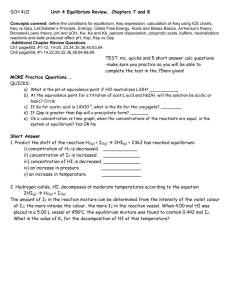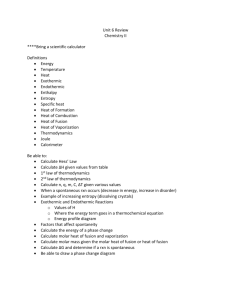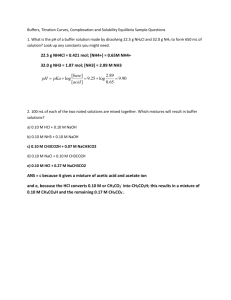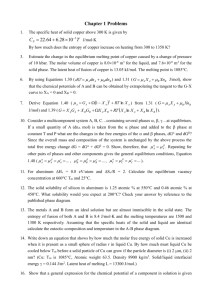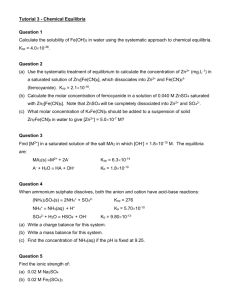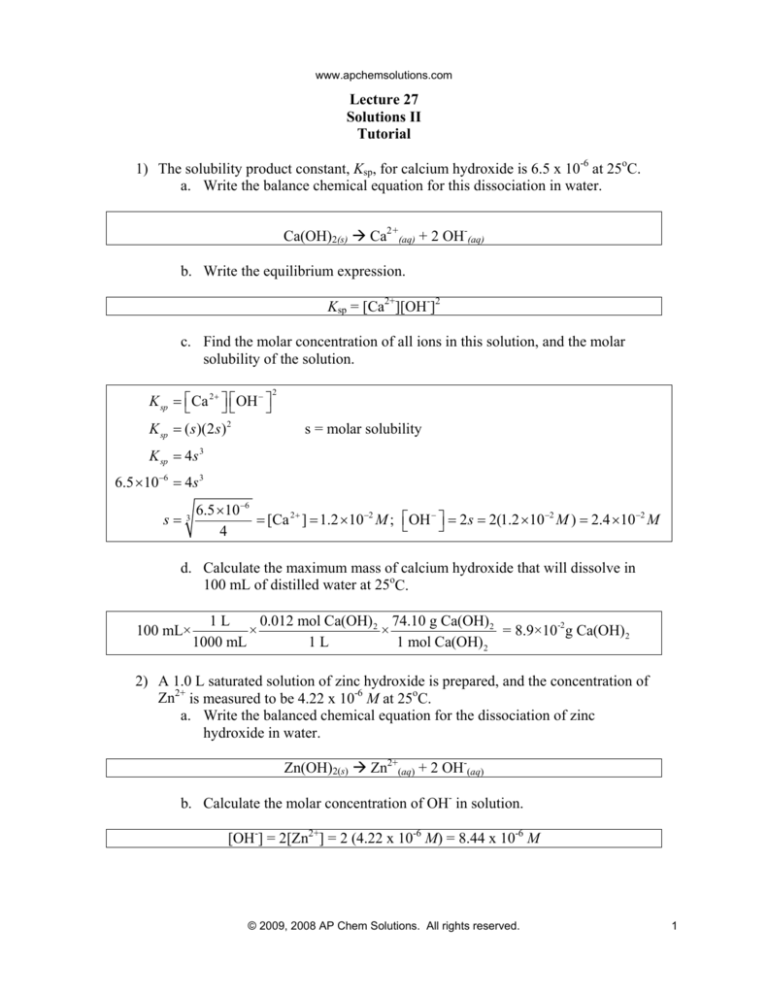
www.apchemsolutions.com
Lecture 27
Solutions II
Tutorial
1) The solubility product constant, Ksp, for calcium hydroxide is 6.5 x 10-6 at 25oC.
a. Write the balance chemical equation for this dissociation in water.
Ca(OH)2(s) Æ Ca2+(aq) + 2 OH-(aq)
b. Write the equilibrium expression.
Ksp = [Ca2+][OH-]2
c. Find the molar concentration of all ions in this solution, and the molar
solubility of the solution.
K sp = ⎡⎣ Ca 2+ ⎤⎦ ⎡⎣OH − ⎤⎦
K sp = ( s )(2 s ) 2
2
s = molar solubility
K sp = 4s 3
6.5 ×10−6 = 4s 3
s=
3
6.5 ×10−6
= [Ca 2+ ] = 1.2 ×10−2 M ; ⎡⎣OH − ⎤⎦ = 2 s = 2(1.2 ×10−2 M ) = 2.4 ×10−2 M
4
d. Calculate the maximum mass of calcium hydroxide that will dissolve in
100 mL of distilled water at 25oC.
100 mL×
0.012 mol Ca(OH) 2 74.10 g Ca(OH) 2
1L
×
×
= 8.9×10-2 g Ca(OH)2
1000 mL
1L
1 mol Ca(OH) 2
2) A 1.0 L saturated solution of zinc hydroxide is prepared, and the concentration of
Zn2+ is measured to be 4.22 x 10-6 M at 25oC.
a. Write the balanced chemical equation for the dissociation of zinc
hydroxide in water.
Zn(OH)2(s) Æ Zn2+(aq) + 2 OH-(aq)
b. Calculate the molar concentration of OH- in solution.
[OH-] = 2[Zn2+] = 2 (4.22 x 10-6 M) = 8.44 x 10-6 M
© 2009, 2008 AP Chem Solutions. All rights reserved.
1
www.apchemsolutions.com
c. Calculate the value of the solubility product constant, Ksp.
K sp = [Zn 2+ ][OH − ]2 = (4.22 x 10−6 )(8.44 x 10−6 ) 2 = 3.01×10−16 M
d. Calculate the maximum mass of zinc hydroxide that will dissolve in
150 mL of distilled water at 25oC
150 mL×
4.22×10-6 mol Zn(OH) 2 99.41 g Zn(OH) 2
1L
×
×
= 6.3×10-5g Zn(OH) 2
1000 mL
1L
1 mol Zn(OH) 2
e. What is the molar concentration of Zn2+ if 200 mL of water evaporates
from the solution?
[Zn2+] = 4.22 x 10-6 M
Concentration is not affected by changes in volume.
3) Will a precipitate form when 350 mL of 5.5 x 10-2 M lead (II) nitrate is mixed
with 250 mL of 4.8 x 10-2 M sodium iodide. (Ksp for PbI2 is 9.77 x 10-10.)
5.5 × 10-2 mol Pb 2+
= 1.9 ×10−2 mol Pb 2+
1 L solution
-2
1.9×10 mol Pb 2+
= 3.2 × 10−2 M
[Pb 2 + ] =
0.35 L + 0.25 L
Find [Pb 2 + ]
0.35 L solution ×
Find [I − ]
4.8×10-2 mol I= 1.2×10-2 mol I1 L solution
-2
1.2×10 mol I[I- ]=
= 0.020M
0.35 L+0.25 L
0.25 L solution×
Q = [Pb 2 + ][I− ]2 = (3.2 × 10−2 )(0.020) 2 = 1.28 ×10−5 M
Q > K sp , so a precipitate will form
© 2009, 2008 AP Chem Solutions. All rights reserved.
2
www.apchemsolutions.com
4) If a 0.50 M solution of K2SO4 is slowly poured into a beaker containing 0.25 M
barium nitrate and 0.30 M lead (II) nitrate at 25oC, what will be the first
precipitate that forms? Ksp for barium sulfate is 1.1 x 10-10 and Ksp for lead (II)
sulfate is 1.6 x 10-8.
BaSO 4( s ) → Ba 2+ ( aq ) + SO 4 2− ( aq )
[SO 4 2− ] =
K sp
[Ba 2+ ]
=
K sp = [Ba 2+ ][SO 4 2− ]
1.1× 10−10
= 3.7 ×10−10 M
0.30 M
PbSO 4( s ) → Pb 2+ ( aq ) + SO 4 2− ( aq )
[SO 4 2− ] =
K sp
[Pb 2+ ]
=
K sp = [Pb 2+ ][SO 4 2− ]
1.6 × 10−8
= 6.4 × 10−8 M
0.25M
BaSO 4( s ) will be the first precipitate that forms, as [SO 4 2− ] will reach 3.7 ×10−10 M
before it reaches 6.4 × 10−8 M .
5) Explain why NO(g) is more soluble in water than O2(g).
NO is larger than O2, as nitrogen has a bigger radius than oxygen, and the bond between
nitrogen and oxygen is slightly polar (electronegativity different of 0.5). Thus, NO
experiences larger dispersion force and dipole-dipole forces when it dissolves in water.
This makes it more soluble.
© 2009, 2008 AP Chem Solutions. All rights reserved.
3

